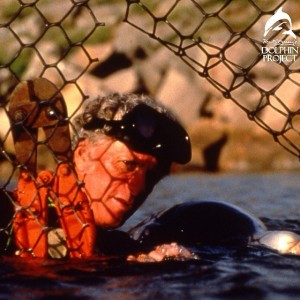“If there’s a dolphin anywhere in the world that’s in trouble, my phone rings.”
O’Barry’s first act of civil obedience was sparked off by Kathy’s death in 1970. The day after she died, he immediately headed off to Bimini, in the Bahamas, to free Charlie Brown, a dolphin he knew was being held captive there. His attempt ultimately failed, as Charlie Brown refused to swim out of his pen, and O’Barry was arrested and thrown in jail. He was charged with trespassing and got off with a $5 fine. Charlie Brown died 2 years later in captivity of malnutrition.
After the Bimini incident, O’Barry decided to go into dolphin research, to work to free captive dolphins and protect wild ones, but not in the way he had done in Bimini. That had been a failure, a lesson he learnt well, and this time he wanted to do things in a more structured legal way. With the help of funds from Fred Neil and Steven Stills, O’Barry officially set up the Dolphin Project, with its aim of ending all exploitation and slaughter of dolphins.
1973 – O’Barry receives a call from David Kent about captive dolphin on display in Everglades. He heads down and finds two dolphins being kept in deplorable conditions, and their habitat even contained fresh water. He informs state officials, and a week later, the Florida Department of Natural Resources orders the return of the dolphins to the sea, which is complied with.
1975 – Florida & Liberty, two dolphins owned by the Dolphin Project for research are rehabilitated and released back into the wild in the Bahamas.
1980s – spent the majority of his time rehabilitating dolphins in Israel, Brazil, and Central America. He also worked sporadically as a stuntman, raising what funds he could for the Dolphin Project.
1989 – campaigns against the U.S. Navy’s use of dolphins in their military operations. The Navy had first approached him in the 1960s when they were starting the Marine Mammal Program, to be a trainer for the dolphins, an offer he refused.
The constant movement and instability put a strain on his marriage, and he and his wife Martha divorce in 1990.
1990s – continuation of efforts to free captive dolphins around the world.
1993 – rehabilitates and releases Flipper, the last captive dolphin in Brazil back into the wild.
1994 – the Navy sends 3 of its dolphins to O’Barry to be rehabilitated and released.
1996 – Buck & Luther, two of the former Navy dolphins, are released without the proper permits from the National Marine Fisheries Service (NMFS). They are recaptured 2 weeks later. Buck is sent to the Dolphin Research Center and dies in captivity, while Luther is returned to active duty in the Navy.
1999 – O’Barry and his associate Lloyd A. Good, lll are convicted of violating the Marine Mammal Protection Act (MMPA) for the release of Buck & Luther and are fined.
2000s – more dolphin activism
2003 – visits Taiji, Japan, for the first time to experience first hand the brutal dolphin hunts that are being carried out there. Over the next few years, he repeatedly travels back there, trying to get video and photographic evidence of the slaughters going on, to no avail. He still goes there every year.
2008 – convinces the Dominican Republic government to refuse the importation of a dozen dolphins caught in the Taji hunt for the Ocean World Casino and Aquarium. As a result, he was sued for $460 million by Ocean World, and the lawsuit is still ongoing.
2009 – the documentary The Cove is released.
2014 – the Dolphin Project files a lawsuit against the Taiji Whale Museum.



